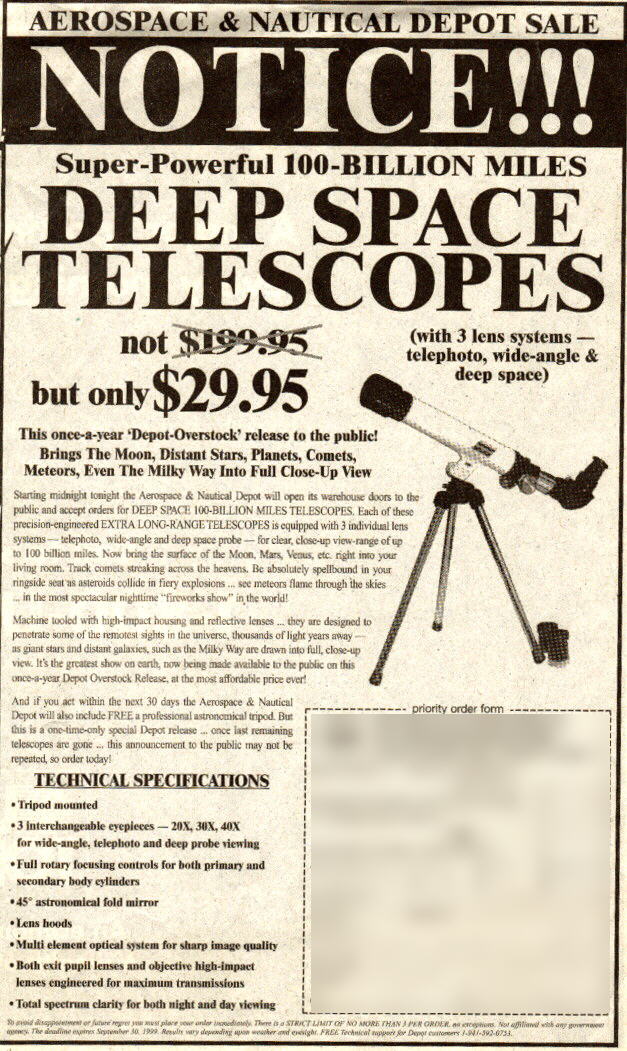This page updated 26 January 2001
A Typical Junk Telescope Ad
Below is an ad for an absolutely worthless telescope. Take a look at this ad, then read my analysis of the "features" of this scope below....

OK, let's take a look at what this ad is saying in a little more detail...
- Super Powerful 100 Billion Miles This is your first clue that the scope is worthless. 100 billion miles? If that's as far as it can see, then you can't see a single star with it (other than the Sun)! The nearest star (other than the Sun) is about 4 light years away, or roughly 24 trillion miles out. And consider this: when you look at the Andromeda Galaxy (visible with your unaided eye), you are seeing something roughly 2 million light years away, or about 120 million times farther than this scope is advertised to see!
- Now bring the surface of the Moon, Mars, Venus, etc. right into your living room For one, you would never want to observe from your living room for several reasons. First, you'd probably be looking through the window glass, something that will degrade the image to a high degree (maybe not for this scope however because the image is likely to be very bad anyway). Second, the thermal currents in and around an open window will only further degrade the image. It is true you can probably see some surface detail on the Moon with this scope, however viewing the "surface" of the planets mentioned is stretching things to the limit. You could probably "see" the planets mentioned, but as for surface detail, forget it. Mars is a difficult target even for expensive telescopes, and Venus' surface is permanently covered by clouds. On Jupiter you might (at best) see two cloud bands around the center of the planet...
- Track Comets streaking across the Heavens Comets do not "streak" across the heavens (as do meteors); comets do move but the movement is typically noticeable only over the course of a night or two. And, with a scope like this, you'd need a comet as bright as Hale Bopp or Hyakutake to have a chance to see anything. Even marginal binoculars would "blow away" the view this scope is likely to provide!
- Be absolutely spellbound in your ringside seat as asteroids collide in fiery explosions... This is perhaps the most preposterous claim in this ad... totally made up B.S. No one has ever witnessed such an event! The odds of two asteroids colliding are about as good as you winning the million dollar lottery every day for a week! In fact, most asteroids are far too faint for this scope to detect. To find an asteroid, you need a detailed chart that shows the location of the asteroid, it is not something that a "first time astronomer" is going to do (especially with this scope). The only documented event of anything resembling an astronomical "fiery collision" was the impact of Comet Shoemaker-Levy 9 on Jupiter in 1994. This was an exceedingly rare event in human lifetime terms!
- See meteors flame through the skies More garbage. The best equipment for viewing meteors is your naked eye. A telescope is useless for meteor viewing because the meteor will come and go before you have any chance to get a scope anywhere near it. Even if you could track it, it would only look brighter!
- Machine tooled with high-impact housing and reflective lenses Machine tooled? Garbage. None of the stuff on this scope is "machined" in the normal sense of the word. Hi-impact housing? Translation: plastic. And to top it off: Reflective lenses? What crap! You want lenses to transmit light, not reflect it!!! No doubt these lenses are very good at reflecting light because they have no anti-reflection coatings (standard equipment on even marginal optics).
- Full rotary focusing controls for both primary and secondary body cylinders Just some fancy words to state that this scope can be focused, something that is standard on any telescope...
- Multi element optical system for sharp image quality No details provided here, I would not be surprised to learn that this scope is not even a simple achromat (the simplest refractor lens system). The next line is even more disturbing...
- Both exit pupil lenses and objective high-impact lenses engineered for maximum transmissions This is scary. "Hi-impact lenses"? This to me means PLASTIC. There is some truth here... it does take some engineering expertise to maximize the light transmission of PLASTIC lenses! Plastic lenses are found on only the very poorest quality telescopes. The bottom line: plastic lenses may be OK for things like household magnifying lenses, but plastic is not a suitable material for astronomical lenses.
Overall, you'd be well advised to steer clear of a scope like this. This ad is one of the most extreme examples of telescope BS I have ever seen. The wording is geared to take advantage of those who are not familiar with telescopes or astronomy. Some of the claims are absolutely false (the bit about asteroid colliding) and the performance claims border on fraud. If you purchase this telescope you will have succeeded only in wasting $30. Look at it another way: this scope makes the typical "department store" telescope look like a gem!
"Back" links, e-mail and Copyright
Use your browser's "back" button, or use links below if you arrived here via some other path:
This page is part of the site Amateur Astronomer's Notebook
E-mail to Joe
Roberts
HTML text © Copyright 2000 by Joe Roberts.

